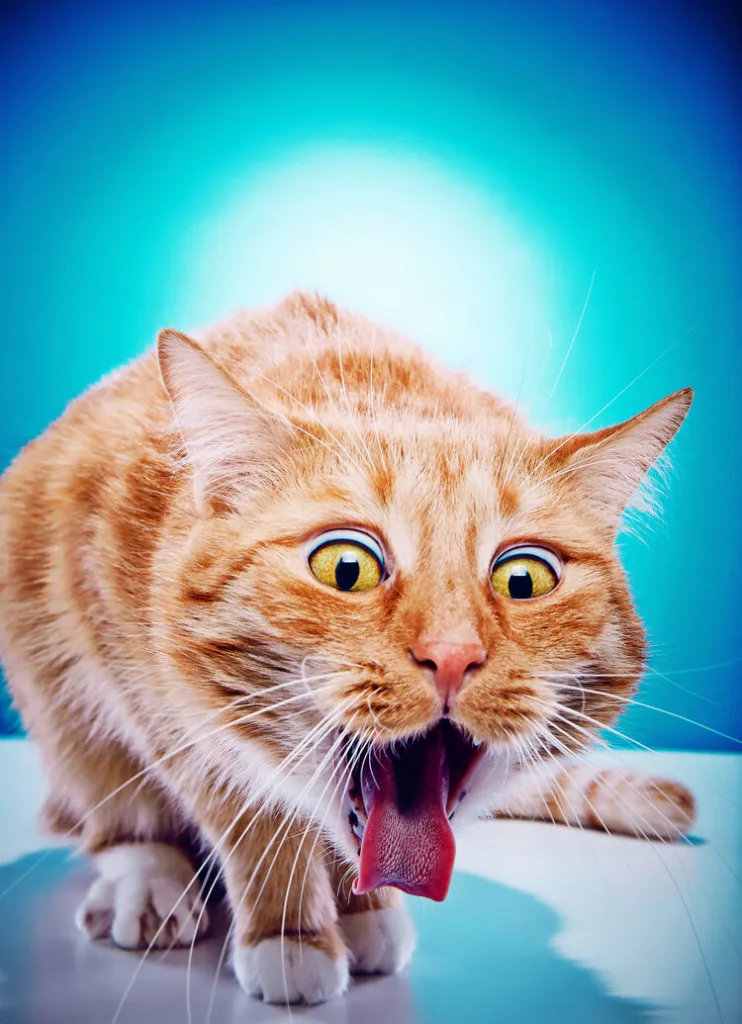Cats are known for their grooming habits and their ability to vomit from time to time. While occasional vomiting is normal for cats, it is important to pay attention to the color of the vomit, as it can give us clues about their health.
One concerning color of vomit in cats is pink. Pink vomit indicates the presence of blood in the vomit, which can be a sign of various underlying health issues. It is essential for cat owners to understand the possible causes of pink vomit in order to seek appropriate veterinary care for their furry friends.
One possible cause of pink vomit in cats is active bleeding in the intestinal tract. When the blood mixes with the stomach acid, it can result in pink-colored vomit. This bleeding can be caused by various factors such as gastrointestinal ulcers, tumors, or trauma to the intestinal lining. If you notice your cat vomiting pink, it is crucial to consult with a veterinarian as soon as possible to determine the underlying cause and initiate appropriate treatment.
It is important to note that the color of the blood in the vomit can vary. It can range from bright red to a darker shade, often resembling coffee grounds. If your cat’s vomit has an appearance similar to coffee grounds, it indicates that the blood has been partially digested, which can be a sign of a more severe condition. In such cases, immediate veterinary attention is necessary.
It is also essential to differentiate between spots of blood present in the vomit and the appearance of coffee grounds. Spots of blood may result from irritation caused by vomiting and may not necessarily indicate a serious condition. However, if your cat vomits more than three times, is unable to keep food down, and appears tired or lethargic, it is crucial to seek veterinary care promptly.
Another possible cause of pink vomit in cats is the presence of foreign material in the gastrointestinal tract. If a cat ingests a foreign object that causes a partial or complete blockage, they may vomit when food reaches the blockage and cannot continue through the digestive system. In cases where there is a perforation or associated inflammation, blood may be present in the vomit. If you suspect your cat has ingested a foreign object or if they are experiencing repeated vomiting, it is important to consult with a veterinarian for evaluation and appropriate treatment.
Pink vomit in cats can be a concerning sign and may indicate the presence of blood in the vomit. It is important for cat owners to pay attention to the color of their cat’s vomit and seek veterinary care if they notice pink vomit. The underlying causes of pink vomit can range from gastrointestinal ulcers to foreign object ingestion, and prompt veterinary attention is crucial for proper diagnosis and treatment.

Why Is My Cat Throwing Up Light Red Liquid?
If your cat is throwing up light red liquid, it could indicate several possible causes. However, here are some potential reasons for your cat’s symptoms:
1. Dietary issues: One possible cause is that your cat may have ingested something that is irritating its stomach, such as certain foods, plants, or foreign objects. It’s important to ensure that your cat is not eating anything toxic or indigestible.
2. Gastritis: Gastritis refers to inflammation of the stomach lining, which can cause vomiting. This condition can be caused by various factors, including infections, stress, certain medications, or dietary sensitivities.
3. Gastroenteritis: Gastroenteritis is an inflammation of the stomach and intestines, often caused by a viral or bacterial infection. Along with vomiting, other symptoms may include diarrhea, loss of appetite, and lethargy.
4. Hairballs: Cats are known to groom themselves and ingest their own fur, which can lead to the formation of hairballs. If your cat is unable to expel the hairball through normal digestion, it may vomit it back up. Hairballs typically appear as cylindrical masses of fur.
5. Intestinal parasites: Certain parasites, such as roundworms or tapeworms, can cause digestive disturbances and vomiting in cats. If your cat has not received regular deworming treatments, this possibility should be considered.
6. Stress or anxiety: Cats can be sensitive to changes in their environment or routine, leading to stress or anxiety. This can manifest as vomiting or other digestive issues.
It is crucial to monitor your cat closely for any other symptoms or changes in behavior. If the vomiting persists, becomes more frequent, or is accompanied by other concerning symptoms, it is strongly advised to seek veterinary attention. A veterinarian will be able to conduct a thorough examination, perform diagnostic tests if necessary, and provide appropriate treatment for your cat’s specific condition.
What Does Blood Look Like In Cat Vomit?
When it comes to blood in cat vomit, it can have a couple of different appearances. Firstly, the blood may be bright red in color, which is easily noticeable. On the other hand, it can also appear as dark-colored, resembling “coffee grounds”. This dark color is due to the blood being partially digested.
It is important to note that these two types of blood in cat vomit can be distinguished from mere spots of blood present in the vomit. Spots of blood may be a result of irritation caused by the act of vomiting itself.
To summarize, blood in cat vomit can either be bright red or dark and coffee ground-like in appearance. Spots of blood in the vomit, however, are typically caused by irritation.
When Should I Be Concerned About My Cat Vomiting?
If your feline friend starts vomiting, it’s fairly common and usually not a cause for immediate concern. However, there are certain situations when you should be more cautious and consider seeking veterinary care. Here are some signs to look out for:
1. Frequency: If your cat vomits more than three times within a 24-hour period, it’s a cause for concern. Persistent vomiting can lead to dehydration and other complications.
2. Inability to keep food down: If your cat cannot keep any food or water down, it may indicate a more serious underlying issue. This could be a sign of an obstruction or gastrointestinal problem that requires veterinary attention.
3. Lethargy: If your cat is unusually tired, weak, or lacks energy along with vomiting, it may indicate a more severe condition. This could be a sign of an infection, organ dysfunction, or other serious health problems.
4. Changes in behavior or appetite: If your cat’s vomiting is accompanied by a loss of appetite, weight loss, or changes in behavior, it’s important to consult a vet. These could be signs of a more significant health issue that needs to be addressed.
5. Blood in vomit: If you notice blood in your cat’s vomit, it could be a sign of gastrointestinal bleeding or other internal issues. This requires immediate veterinary attention.
Remember, this information is not a substitute for professional veterinary advice. If you have any concerns about your cat’s health, it’s always best to consult with a veterinarian. They can provide a proper diagnosis and recommend the necessary treatment for your furry friend.
Why Is My Cat Throwing Up Blood After A Hairball?
When a cat throws up blood after a hairball, it could be a sign of various underlying issues. One possible explanation is that the hairball has caused irritation or inflammation in the cat’s esophagus or stomach, leading to bleeding. The forceful act of coughing up the hairball can also cause small blood vessels to rupture, resulting in blood being present in the vomit. Additionally, if the hairball has caused a blockage in the intestines, it can put pressure on the gastrointestinal lining, leading to bleeding.
It’s important to note that throwing up blood after a hairball is not a normal occurrence and should be taken seriously. If your cat is consistently vomiting blood or if the amount of blood increases, it is crucial to seek veterinary attention immediately.
Possible reasons why your cat may be throwing up blood after a hairball include:
1. Esophagitis: The hairball may have caused irritation or inflammation in the esophagus, leading to bleeding.
2. Gastritis: The hairball could have irritated the stomach lining, causing inflammation and subsequent bleeding.
3. Gastrointestinal blockage: If the hairball has not passed through the digestive system and is causing a partial or complete obstruction, it can lead to vomiting, including blood.
4. Ulcers: The pressure exerted by the hairball in the stomach or esophagus can cause ulcers to form, resulting in bleeding.
5. Other underlying conditions: In some cases, the presence of blood after vomiting a hairball could be a symptom of an underlying condition, such as gastrointestinal tumors or infections.
It is important to contact a veterinarian for a proper diagnosis and appropriate treatment. They will be able to assess your cat’s condition, conduct any necessary tests, and provide the most suitable course of action to address the underlying cause of the vomiting and blood.
Conclusion
Pink vomit in cats can be a cause for concern as it may indicate active bleeding in the intestinal tract. The color of the blood can vary from bright red to darker shades, resembling coffee grounds. It is important to differentiate between spots of blood caused by irritation and a more significant amount of blood present in the vomit. If a cat vomits more than three times, is unable to keep food down, and appears tired, it is crucial to seek veterinary attention promptly.
One possible cause of pink vomit in cats is the presence of foreign material in the intestinal tract, leading to a partial or complete blockage. When the cat’s food reaches the blockage, it cannot pass through the gastrointestinal tract, resulting in vomiting. If there is a perforation or inflammation associated with the blockage, blood may be present in the vomit.
Any instance of pink vomit in cats should not be ignored, as it may be indicative of an underlying health issue. Seeking veterinary care is essential to determine the cause and provide appropriate treatment to ensure the cat’s well-being.












